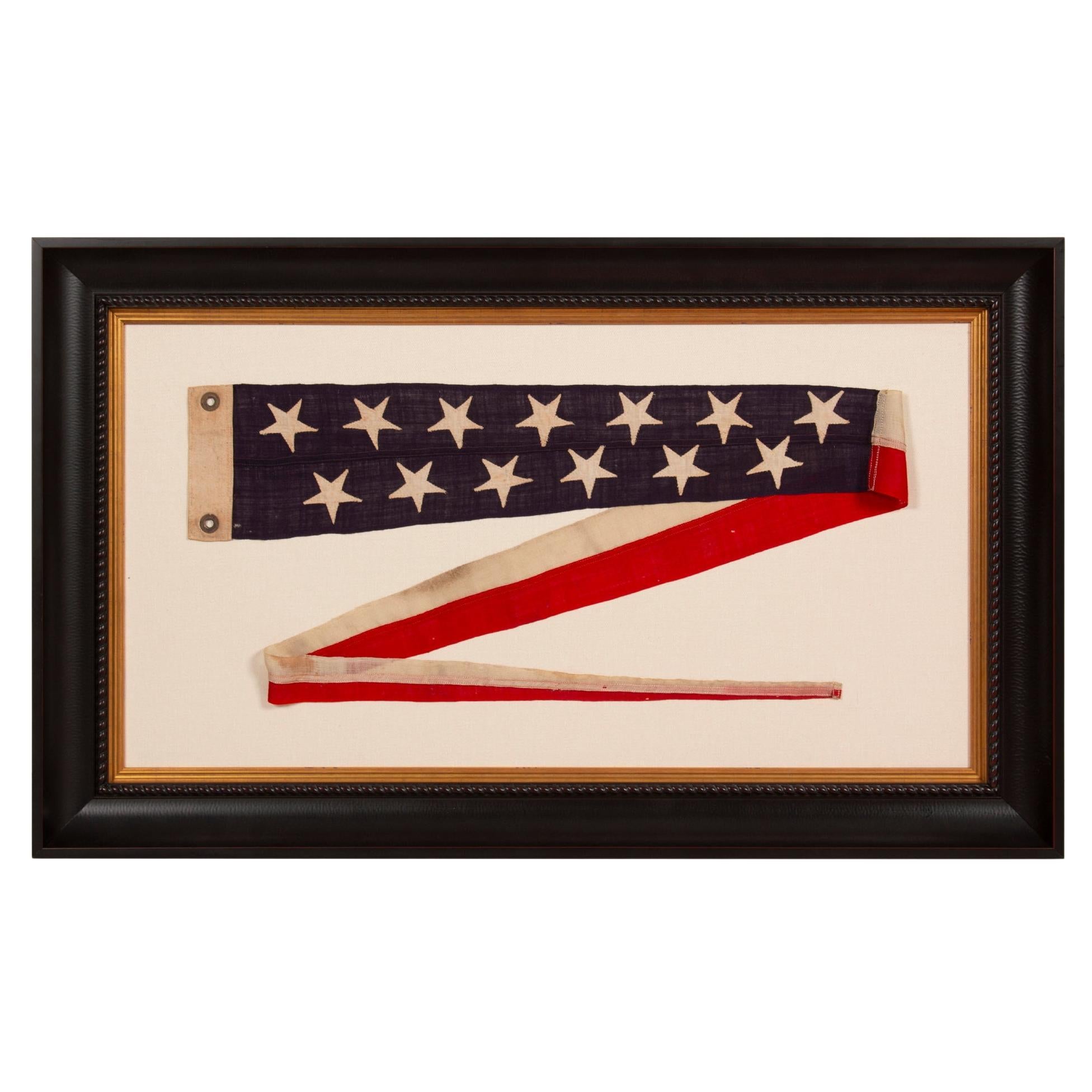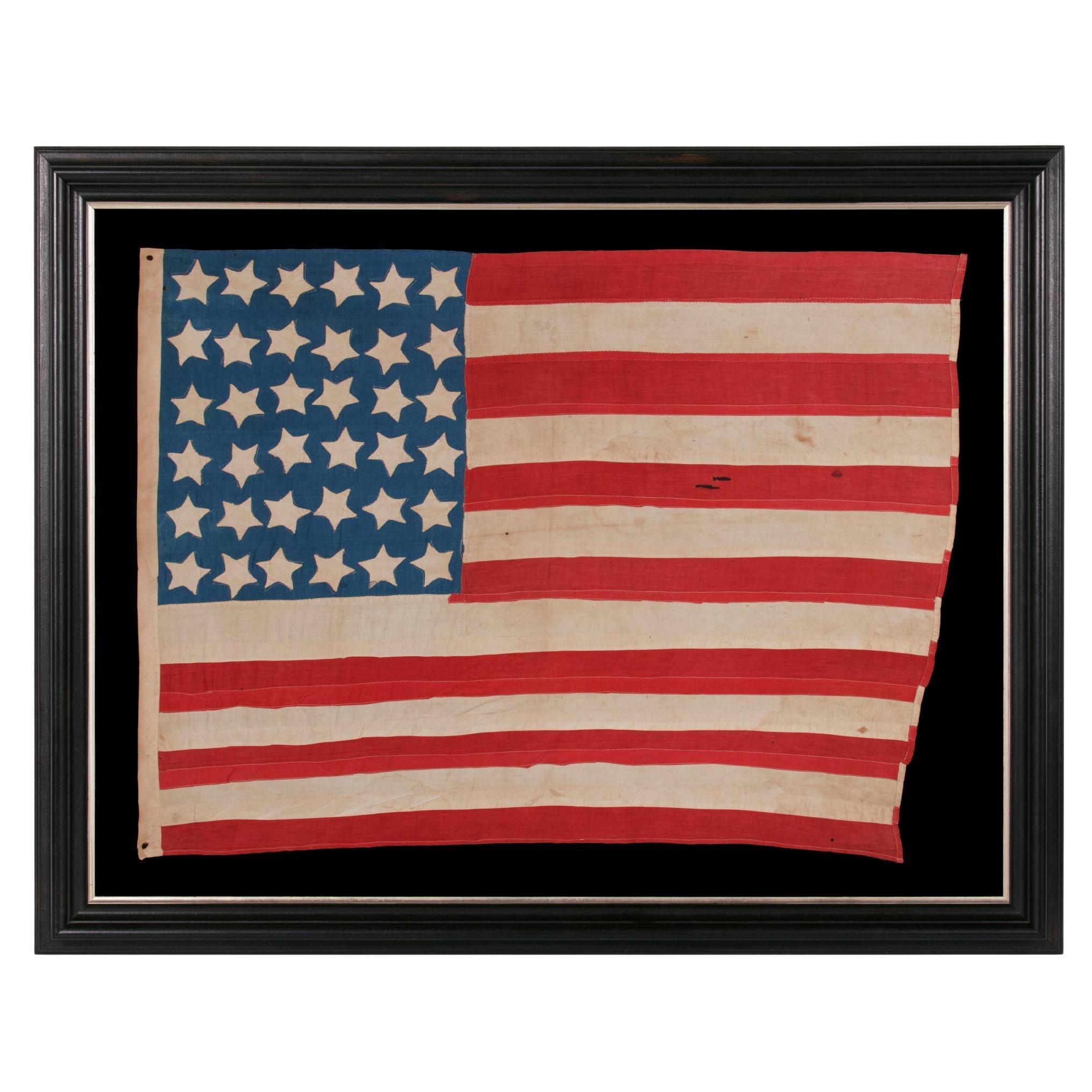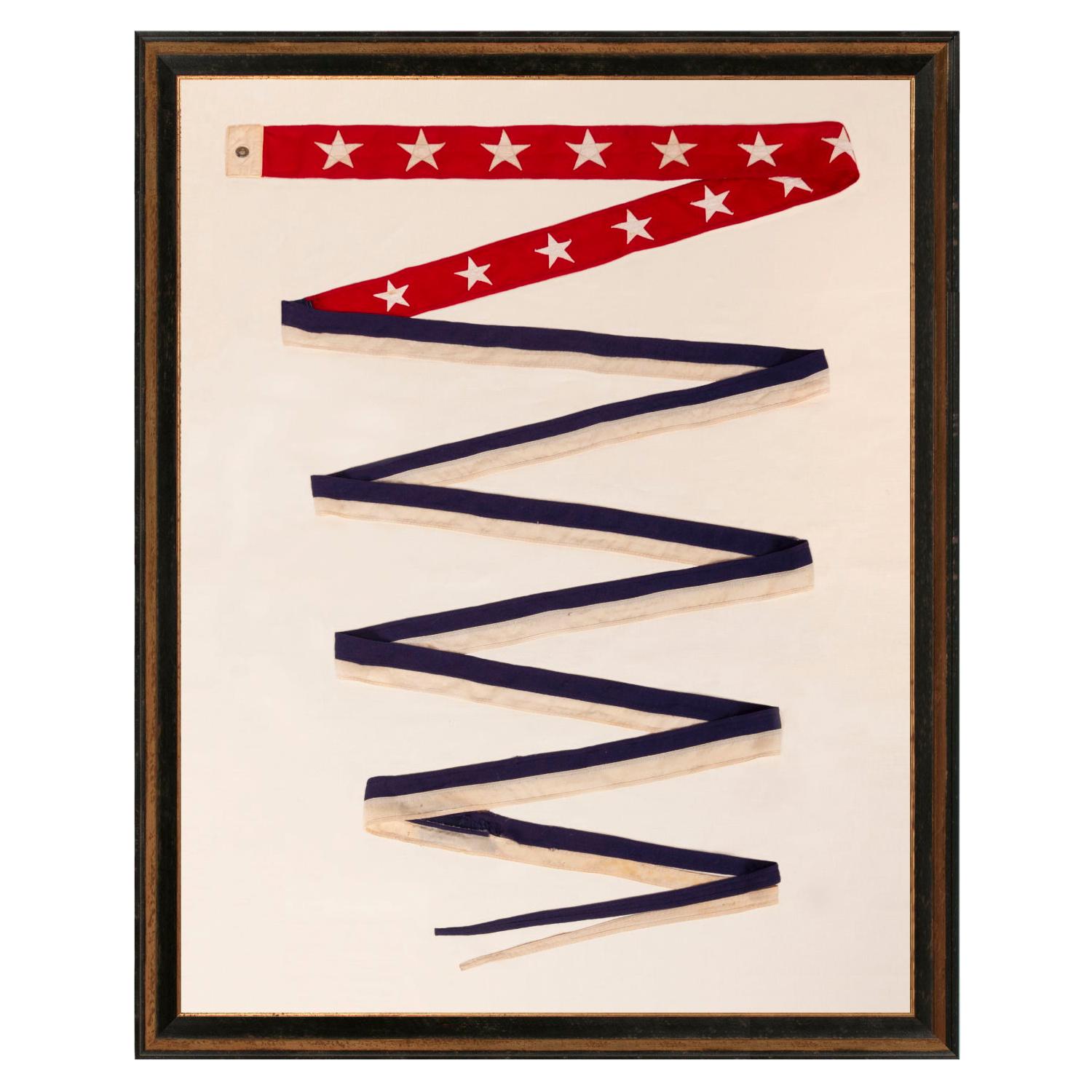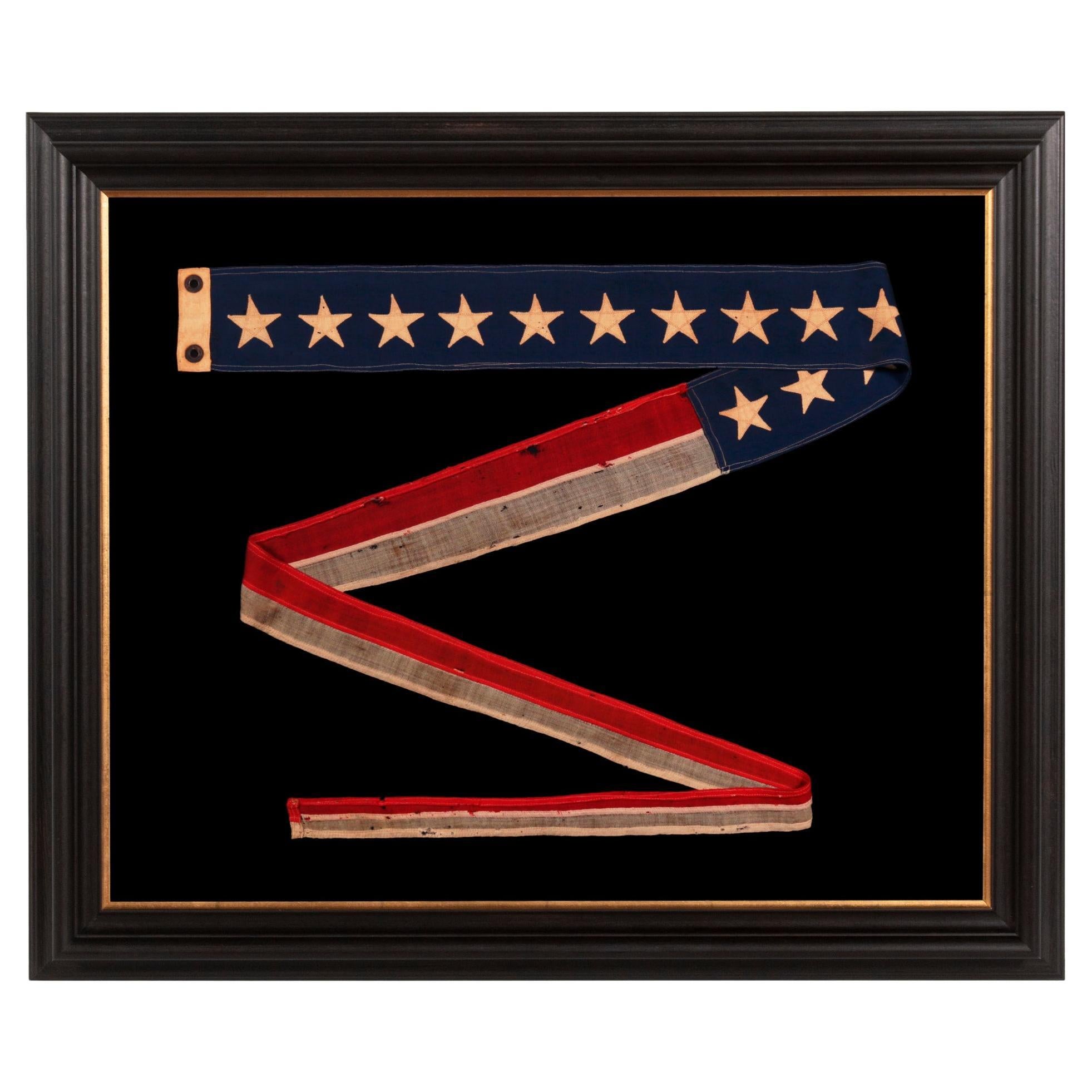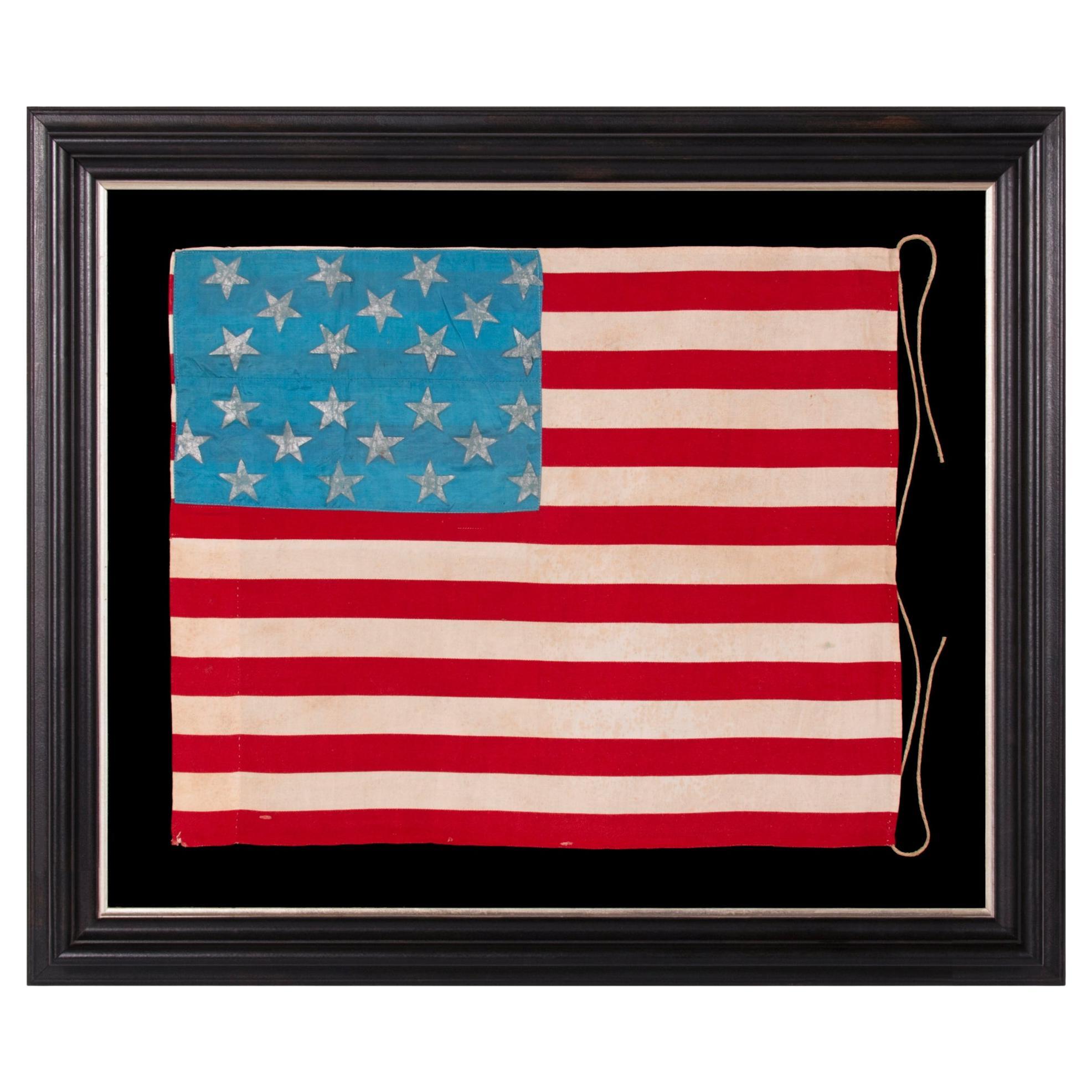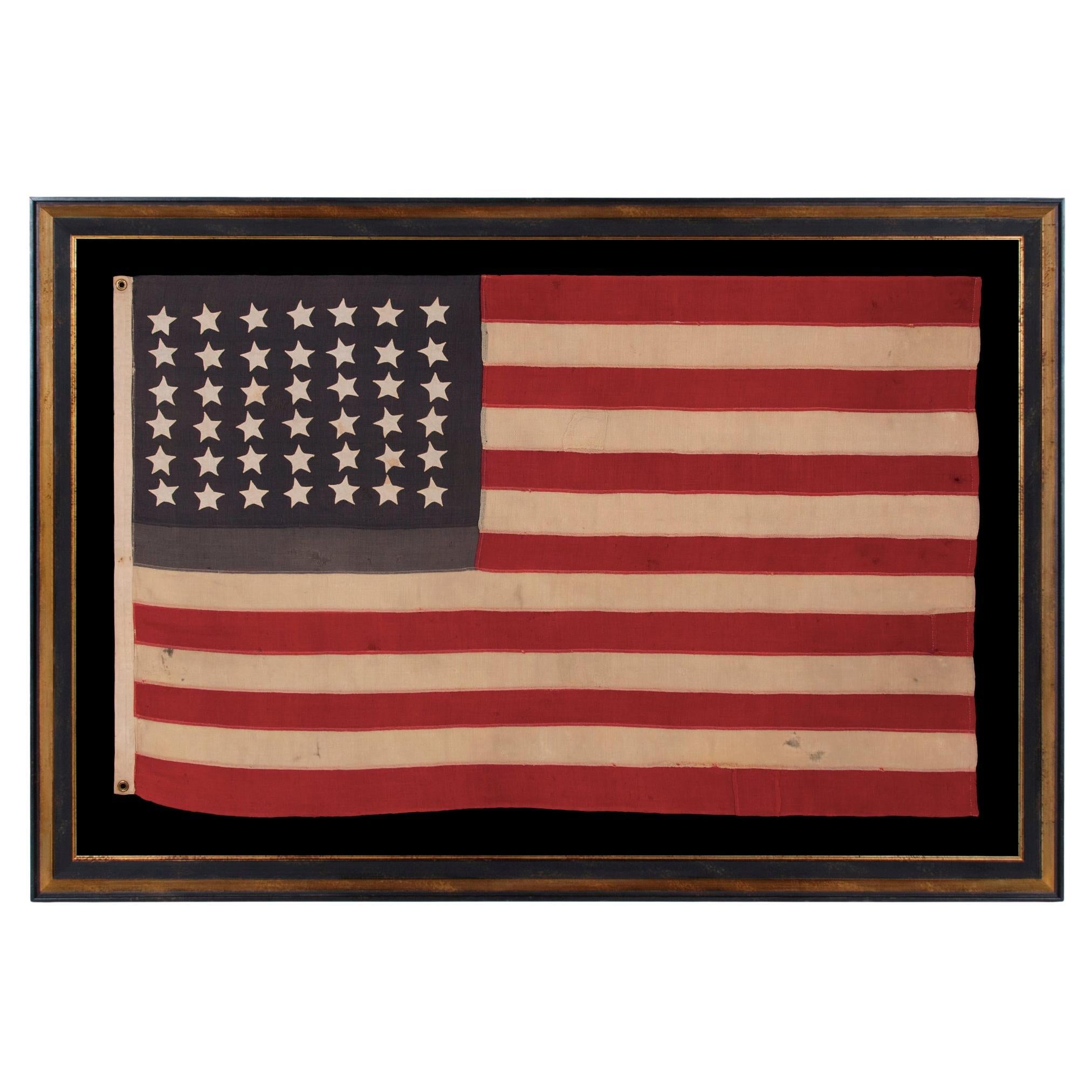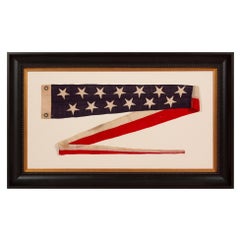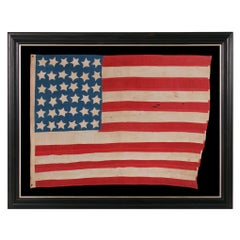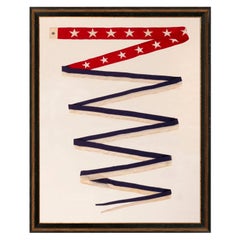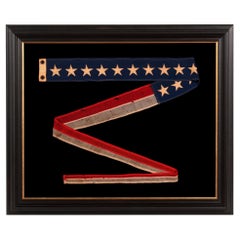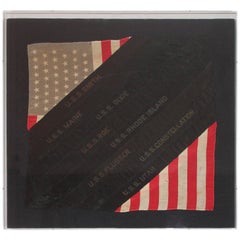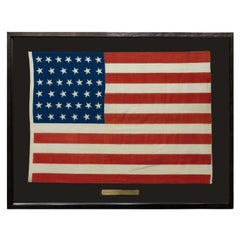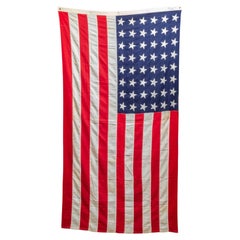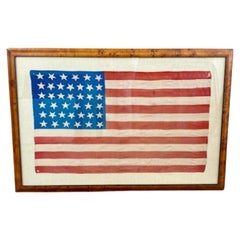Items Similar to Hand-Sewn 13 Star Cornflower Blue 32 Foot Commission Pennant circa 1845-1865
Want more images or videos?
Request additional images or videos from the seller
1 of 7
Hand-Sewn 13 Star Cornflower Blue 32 Foot Commission Pennant circa 1845-1865
Price Upon Request
Price Upon Request
Price Upon Request
Price Upon Request
Price Upon Request
Price Upon Request
Price Upon Request
Price Upon Request
Price Upon Request
Price Upon Request
Shipping
Retrieving quote...The 1stDibs Promise:
Authenticity Guarantee,
Money-Back Guarantee,
24-Hour Cancellation
About the Item
ENTIRELY HAND-SEWN, 32-FOOT, SHIP’S COMMISSION PENNANT OF THE 1845-1865 ERA, A HOMEMADE, COTTON EXAMPLE, WITH 13 STARS ON A CORNFLOWER BLUE CANTON, IN A BEAUTIFUL STATE OF PRESERVATION
Commission pennants are the distinguishing mark of a commissioned U.S. Navy ship. A ship becomes commissioned when the pennant is hoisted. Flown during both times of peace and war, the only time it is not flown is if a flag officer or civilian official is aboard and replaces it with their own flag. Flown at the topmast, this would be the first thing one would see coming over the horizon and identified the vessel as a warship.
Sometimes the owners of private ships mimicked the use of Navy signals. Some seafaring men would have served in the Navy and become privy to various practices in that capacity. Others flew them purely for stylistic reasons, either on a regular basis or while the boat was dressed for special occasion. Hudson River steamers regularly flew pennants of this nature, as evidenced by period photography as well as the paintings of artists such as John and James Bard. Mississippi riverboats likely flew them, as did various yachts, and other private vessels.
This particular commission pennant is a homemade example. Made of cotton and entirely hand-sewn throughout, its 13 stars are arranged in 2 rows of 6, with a single star beyond, centered at the fly end. Note the beautiful shade of cornflower blue, which adds a great deal to its visual qualities. There is a wooden hoist, made of poplar, with a single, drilled hole, to which a rope would be affixed that would let the pennant spin freely. This was tacked to a length of the same blue cotton with large copper tacks, on the reverse, run straight through, with the tips curled over so that they stayed properly in place. I have not before seen copper tacks employed in this function on any sort of flag or banner. The two lengths of fabric were hemmed with three rows of stitching.
Because cotton absorbs water, making it heavier, making it subject to weakness and, potentially, to mold and decay, it was typically not the fabric of choice for flags intended for maritime use. Wool sheds water. Prior to WWII (U.S. involvement 1941-45), most flags intended to be flown outdoors for any extended period were made of wool bunting, which had an open weave that encouraged airflow and further resisted absorption. Since wool bunting wasn’t widely available outside the flag and sail-making industries, however, in spite of its disadvantages, cotton was usually the fabric of choice for homemade flags.
During the 18th and early 19th centuries, commission pennants could 100 feet long on the fly. Although rather large among commission pennants that have survived into the 21st century, at approximately 32-feet on the fly, the flag is actually of fairly modest scale among its counterparts.
During the second and third quarters of the 19th century, pennants measuring 35 feet and less seem to have almost universally been manufactured with the 13 star count. Longer pennants would display a count of stars equal to the number of states at the time in which they were made. As the turn-of-the-century approached, and more and more states were added, commission pennants generally became smaller and the star count was commonly reduced to either 13 stars, or a count of just 7, the reason for which remains unknown, even within the Navy itself. During and after WWI (U.S. involvement 1917-1918), the size of these pennants was drastically reduced, as their use changed became a matter of tradition rather than of any importance as signals. From this era forward, two sizes are generally encountered, measuring just 4 and 6 feet on the fly.
This particular pennant was found alongside large 34 and 35 star flags. The construction and fabrics suggest that it was made between the latter 1840’s and the 1860’s. Though lacking any specific history, the fabrics and construction, the scale, and circumstance of its finding suggest that it was somehow related to the flags that accompanied it, and thus dates to the Civil War time frame (1861-65). Despite not having been made of wool, it is possible that the pennant saw Navy use. Perhaps its cotton construction was not a function of it being the proper fabric for use at sea, but rather a matter of need in the face of shortage of necessary materials. Whatever the case may be, the extreme scarcity of 19th century commission pennants, the wonderful blue color, its uncommon configuration of 13 stars, hand-sewn construction, and exceptional overall presentation, make it an extraordinary find.
Mounting: The pennant was mounted and framed within our own conservation department, which is led by expert staff. We take great care in the mounting and presentation of flags and have preserved thousands of examples.
For ease of display and visual interest, we folded the textile back-and-forth in a zigzag fashion. The background fabric is 100% cotton twill, black in color, that was washed and treated for color fastness. The black-painted, Italian molding has mahogany-like graining and a very deep profile. To this a flat profile molding, with a finish like old gunmetal, was added as a liner. The glazing is U.V. protective acrylic (Plexiglas).
Condition: There are minor to moderate tears throughout, but very little in way of fabric loss. There is moderate fading of the red cotton and there is modest soiling in the white cotton. Many of my clients prefer early flags to show their age and history of use.
- Dimensions:Height: 74.5 in (189.23 cm)Width: 70.5 in (179.07 cm)Depth: 5 in (12.7 cm)
- Materials and Techniques:
- Place of Origin:
- Period:
- Date of Manufacture:1845-1865
- Condition:See Item Description.
- Seller Location:York County, PA
- Reference Number:Seller: 13j-16321stDibs: LU849727737132
About the Seller
5.0
Recognized Seller
These prestigious sellers are industry leaders and represent the highest echelon for item quality and design.
Established in 1991
1stDibs seller since 2008
70 sales on 1stDibs
Typical response time: 1 to 2 days
- ShippingRetrieving quote...Shipping from: York County, PA
- Return Policy
Authenticity Guarantee
In the unlikely event there’s an issue with an item’s authenticity, contact us within 1 year for a full refund. DetailsMoney-Back Guarantee
If your item is not as described, is damaged in transit, or does not arrive, contact us within 7 days for a full refund. Details24-Hour Cancellation
You have a 24-hour grace period in which to reconsider your purchase, with no questions asked.Vetted Professional Sellers
Our world-class sellers must adhere to strict standards for service and quality, maintaining the integrity of our listings.Price-Match Guarantee
If you find that a seller listed the same item for a lower price elsewhere, we’ll match it.Trusted Global Delivery
Our best-in-class carrier network provides specialized shipping options worldwide, including custom delivery.More From This Seller
View All13 Star Commission Pennant, 6 Foot in Length, ca 1892-1910
Located in York County, PA
6-FOOT SHIP’S COMMISSION PENNANT WITH A 5.5” HOIST AND 13 STARS IN 2 STAGGERED ROWS, LIKELY PRODUCED FOR A PRIVATE VESSEL, circa 1892-1910
Commission pennants are the distinguishing...
Category
Antique 1890s American Political and Patriotic Memorabilia
Materials
Wool
36 Star Antique American Flag, Cornflower blue Canton, circa 1864-1867, Nevada
Located in York County, PA
Antique American Flag With 36 Stars On A Cornflower Blue Canton, Civil War Era, 1864-1867, Reflects The Addition Of Nevada As The 36th State; A Great Folk Exaple With Haphazard Rows Of Starfish-like Stars:
36 star American national flag of the Civil War era with outstanding collector traits. Haphazard rows of fat, starfish-shaped stars fill most of the confines of a brilliant, cornflower blue canton. Note the crude piecing of the thirteen, red and white stripes, joined in an ill-planned manner that results in great variation in width, as well as general irregularity. The 4th red stripe actually falls slightly below the canton, and the height of each does not line up with the corresponding stripe on the reverse. This can clearly be seen at the fly end, which is is turned back and bound to repair obvious extended use in an outdoor environment. Clearly the maker lacked experience in seam work. Lining up the necessary components, so that they could be viewed on both sides, presented a challenge they may have not previously faced. This is also evident in the sewing of the stars, which do not line up on the obverse and reverse sides, as they typically would in a flag sewn by an experienced flag-maker. That said, this is just this kind of homemade charm that fuels interest in early American flags...
Category
Antique 1860s American Political and Patriotic Memorabilia
Materials
Cotton
U.S War Department Commissioning Pennant with 13 Stars
Located in York County, PA
EXTREMELY RARE U.S. WAR DEPARTMENT COMMISSIONING PENNANT WITH 13 STARS, A REVERSAL OF THE U.S. NAVY COLOR SCHEME, TWENTY-FOUR FEET ON THE FLY, SP...
Category
20th Century American Political and Patriotic Memorabilia
Materials
Wool
Price Upon Request
Commission Pennant with 13 Stars, like for Private Vessel, Ca 1892-1910
Located in York County, PA
Commission pennants are the distinguishing mark of a commissioned U.S. Navy ship. Flown at the topmast, the typical American format is a long blue field, usually with a single row of white stars, although sometimes with their total divided into two rows, followed by two long stripes, red-over-white. A ship became commissioned when this pennant was hoisted. Flown during both times of peace and war, the only time the pennant is not flown is if a flag officer or civilian official was aboard and replaced it with their own flag.
Sometimes the owners of private ships mimicked the use of Navy signals. Some seafaring men would have served in the Navy and become privy to various practices in that capacity. Others flew them purely for stylistic reasons, either on a regular basis or while the boat was dressed for special occasion. Hudson River steamers regularly flew pennants of this nature, as evidenced by period photography as well as the paintings of artists such as John and James Bard...
Category
Antique Late 19th Century American Political and Patriotic Memorabilia
Materials
Wool
Price Upon Request
WWII Liberation Flag with 23 Silver Gilt Stars, ca 1944
Located in York County, PA
WWII LIBERATION FLAG w/ 23 SILVER GILT STARS ON A CORNFLOWER BLUE CANTON & 16 STRIPES, MADE TO WELCOME U.S. TROOPS IN FRANCE FOLLOWING LIBERATION FROM...
Category
Vintage 1940s French Political and Patriotic Memorabilia
Materials
Cotton
Price Upon Request
42 Hand Sewn Stars on An Antique American Flag ca 1889-1890
Located in York County, PA
42 HAND-SEWN STARS ON AN ANTIQUE AMERICAN FLAG WITH A TWO-TONE, DUSTY BLUE CANTON, REFLECTS THE ADDITION OF WASHINGTON STATE, MONTANA, AND THE DAKOTAS, NEVER AN OFFICIAL STAR COUNT, ...
Category
Antique Late 19th Century American Political and Patriotic Memorabilia
Materials
Wool
Price Upon Request
You May Also Like
Framed Hand Sewn Patriotic Sham Made from a Flag and Ship Ribbons
Located in Los Angeles, CA
This Great framed Folk Art sham with 48star flag and ship ribbons is a great patriotic item. The top left corner as well as the bottom right corner are scraps of a 48 star linen flag and in between them are ribbons of ships names that are sewn together in a collage. The American ships span three centuries of ships ribbons, from late 19th century to present day ships. As well as the "USS Utah" which was sunk during the attack on Pearl Harbor.
This great and proud sham is not only a great American item but is a Symbol of hope and unity throughout the ages. Serves better as a hanging Folk Art...
Category
20th Century American Folk Art Political and Patriotic Memorabilia
Materials
Plexiglass
39-Star Antique American Flag with 'Whimsical' Star Pattern, 1889
Located in Colorado Springs, CO
This is a 39-star unofficial American flag, handmade and printed on cotton. The flag dates to 1889 and has a unique history, thanks to its rare star-count.
The flag’s canton is prin...
Category
Antique 1880s American Political and Patriotic Memorabilia
Materials
Cotton
Large Hand Sewn American Flag with 48 Stars c.1940-1950
Located in San Francisco, CA
ABOUT
A large hand sewn American flag made with 48 hand sewn stars and stripes with brass grommets to hang.
CREATOR Valley Forge Flag Co.
DATE OF MANUFACTURE c.1940-1950....
Category
Early 20th Century Industrial Political and Patriotic Memorabilia
Materials
Brass
19th Century American 39 Star Flag, circa 1889
Located in Nantucket, MA
19th Century American 39 Star Flag, circa 1889, a period printed silk parade flag with a wavy pattern of dancing stars. This was never an official flag of the United States but was m...
Category
Antique 1880s American Federal Political and Patriotic Memorabilia
Materials
Silk
Antique 13-Star Patriotic Sash by Louis E. Stilz & Bros., Late 19th Century
Located in Colorado Springs, CO
Presented is an original patriotic sash from the late 19th century, featuring 13 stars against a bright blue field. This sash features appliqued silver stars on a blue canton, red an...
Category
Antique Late 19th Century American Historical Memorabilia
Materials
Cotton
38-Star American Parade Flag, Flown at a Reception for President Grant, 1880
Located in Colorado Springs, CO
This is a beautifully colored 38-star American parade flag, flown at a public reception for Ulysses S. Grant in October of 1880. This printed flag features a rare, triple medallion s...
Category
Antique 1880s American Political and Patriotic Memorabilia
Materials
Cotton
